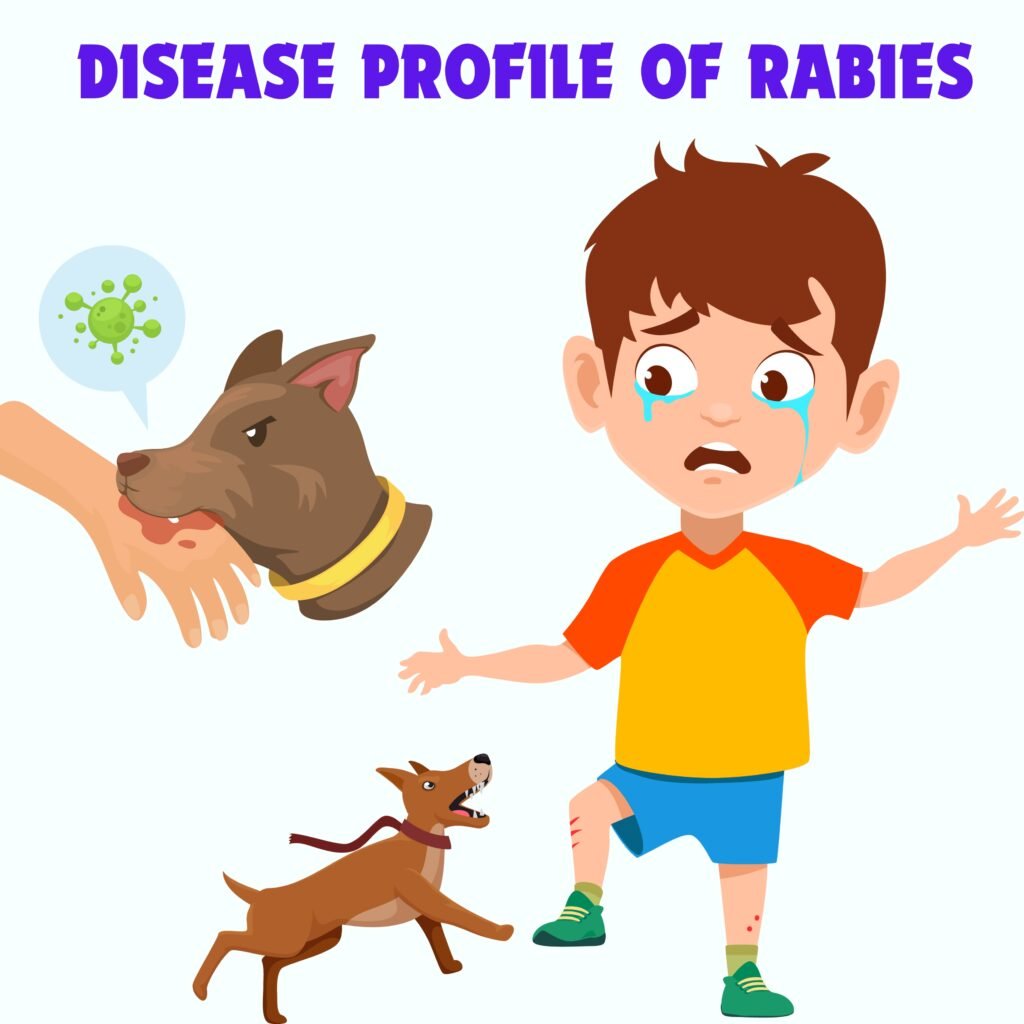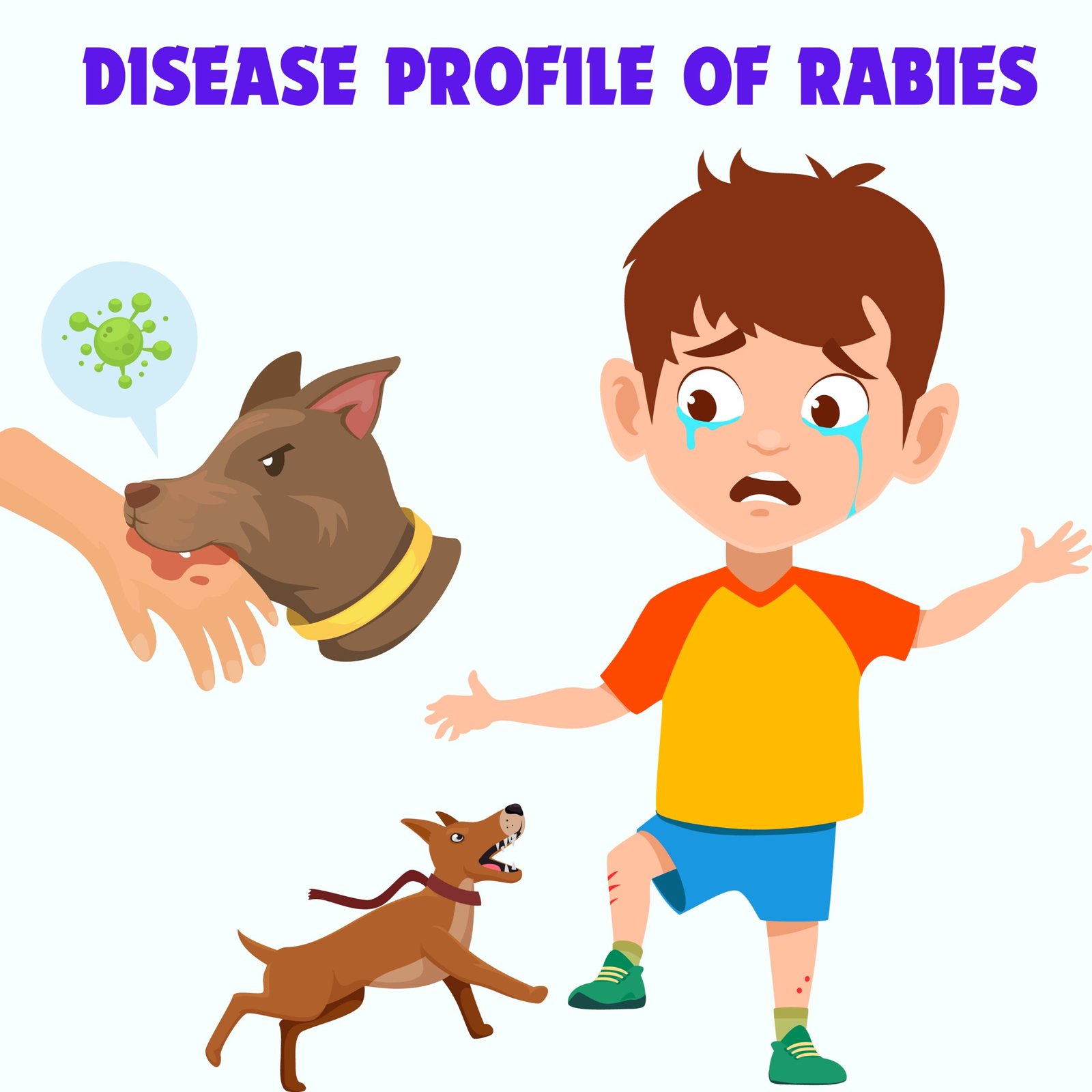Etiology
- Rabies is a zoonotic viral infectious disease caused by rhabdovirus. This infection is
transmitted to human by the animals already suffering from it. The animals which are mainly
reported as causes of rabies are dogs, raccoons, skunks, bats, and foxes. - Rabies virus infects the central nervous tissues and salivary glands of a wide range of
mammals. It is usually conveyed by saliva through bites or licks on abrasions or on intact
mucous membranes. - It is a vaccine-preventable viral disease which occurs in more than 150 countries and
territories. Humans are most frequently infected from dogs. - The incubation period varies in humans from a minimum of 9 days to many months but it is
usually 4 to 8 weeks. - Severe bites especially if on the head or neck are associated with shorter incubation period.
Risk Factors
Factors that increase the chances of getting rabies are following: - Biting mammal is a known rabies reservoir or vector species.
- Biting by unimmunized dog.
- Bite by an animal that looks sick or displays abnormal behavior.
- A wound or mucous membrane was contaminated by the animal’s saliva.
- Failure to use soap and water after bite.
Symptoms
In humans, rabies typically manifests in five stages:
- Incubation period
- Prodrome
- Acute neurologic phase
- Coma
- Death (or in rare instances, recovery).
| Phases | Duration | Symptoms |
| Exposure | — | Often unrecognized |
| Incubation period | 3-4 weeks to 3-4 months | — |
| Prodrome | 1-2 days to 1 week | Fever, headache, nausea, vomiting Anorexia, anxiety,depression, agitation, lethargy |
| Acute neurologic phase | 1-2 days to <1 week | Confusion, delirium, hallucinations Hyper-salivation, hyperactivity, hyperventilation Hydrophobia, Seizures, pharyngeal spasms |
| Coma, and death | Several days to 1 week | Hypoventilation, apnea, respiratory arrest Pituitary dysfunction, Hypo/ hyperthermia, autonomic instability Hypotension, cardiac arrhythmia, cardiac arrest |

Diagnostic Tests

All these techniques are recommended by WHO.
Standard treatment
There is no certain cure for rabies except supportive care. Untreated or inappropriately treated
rabies is almost always fatal because treatment is supportive only to limit the patient’s pain. An fective new rabies treatment regime that gives the protection from the disease is developed by
the scientists. The treatment regimes are; Medications to relieve the symptoms, Post-exposure
prophylaxis, and Pre-exposure prophylaxis.
Medications:
Combination therapy for a patient with rabies includes administration of
- Supportive care
- Nutrition, fluids, vitamin, minerals.
- Provides patient with support to allow immune system to mount response to
virus.
- Therapeutic coma
- Ribavirin (broad-spectrum antiviral agent, given intravenously and intraventricularly
via Ommaya reservoir), - IFN-α (natural immune-regulatory protein and an immunotherapeutic drug for
viral and neoplastic diseases, given intravenously and intra-ventricularly via
Ommaya reservoir) - Ketamine (anesthetic agent and a noncompetitive antagonist of the N-methyl-daspartate
(NMDA) receptor, given as intravenous infusion). - Benzodiazepine (antipsychotic drugs). Diazepam, supplemented by
chlorpromazine if needed.
Pre-exposure prophylaxis - Pre-exposure prophylaxis is required by those who handle potentially infected animals
professionally, work with rabies virus in laboratories, or live at special risk in rabies-endemic
areas. - Protection is afforded by intradermal injections of human diploid cell vaccine (HDCV), 1ml
on days 0, 7,and 21 or 28, or two intramuscular injections given 4 weeks apart, followed by
yearly boosters.
Post-exposure prophylaxis - If a person is bitten by an animal, the wound and scratches should be washed thoroughly with
soap and water to decrease the chances of infection. - Post-exposure prophylaxis has different doses for different patients.
- Patients not previously vaccinated
- Human diploid cell vaccine (HDCV), 1ml on days 0, 3, 7 and 14.
Immunosuppressant individuals should also receive a fifth dose on day 28. - Human rabies immune globulin (HRIG), on days 0-7. On day 0, one dose of
20 IU/kg body weigh should be given; half is infiltrated around the bite and
half is given intramuscularly at a different site from the vaccine.
2.Patients vaccinated within previous 2 years
Human diploid cell vaccine (HDCV), 1ml on days 0 and 3.
- The rabies vaccine works by stimulating a person’s immune system to produce antibodies
that neutralize the virus. Rabies can usually be prevented if treatment is started within a day
or two of biting. - The safest anti-rabies antiserum is human rabies immune globulin. The HRIG is in short
supply. If it is not available immediately, the vaccine series should be initiated and HRIG
may be added at any point through day 7. - After day 7, it is not necessary to add HRIG to patient regimen because endogenous
antibodies are being produced and exogenous antibodies may actually be counterproductive.
Brand Names:

Side Effects of Medications
- Rabies vaccine
Common adverse effects associated with the use of either rabies vaccine include local
injection-site reactions such as erythema, itching, swelling, and indurations, and systemic
reactions such as headache, nausea, abdominal pain, muscle aches, dizziness, and fever. - Ribavirin
Elevated bilirubin levels, dose dependent transient anemia and contradicted in pregnancy. - INF-α
It can lead to severe inflammation in body or autoimmune diseases. - Ketamine
Nausea, vomiting, headache, hypertension, liver dysfunction, dizziness are side effects of
ketamine. - Benzodiazepines
Drowsiness and confusion are the most common adverse effects of benzodiazepines. Ataxia
occurs at high doses.
Counseling Plan - The patient should be nursed in a quiet, darkened room.
- Vaccination should be done according to the days mentioned for efficient therapeutic effects.
- There are few adverse reactions to human diploid cell rabies vaccine because the vaccine
contains fewer foreign proteins. Local pain, swelling, and fever have been reported in about
one half of recipients. Analgesics and antipyretics medicines can be prescribed and counsel
patient to take them when required. - Patients who are taking corticosteroids or are immunosuppressed may not develop active
immunity with the vaccine. Therefore, antibody titers may need to be monitored for these
individuals to ensure that they have developed antibody levels that will protect them from
rabies. - Counsel patient to take nutritional supplement to boost their immunity.
- Common ADRs must be addressed to patients to increase patient compliance.

